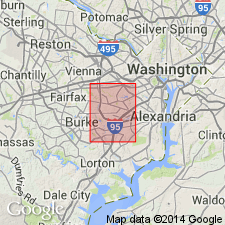
- Usage in publication:
-
- Falls Church Tonalite*
- Modifications:
-
- Named
- Dominant lithology:
-
- Tonalite
- AAPG geologic province:
-
- Piedmont-Blue Ridge province
Summary:
The Falls Church Tonalite, here named, forms the Falls Church, Ilda, and several smaller plutons in the Annandale quad. It consists of medium- to coarse-grained gray tonalite with lesser granodiorite and monzogranite, and small xenoliths of mafic igneous rocks. Outcrops are massive in appearance, but most are foliated. It and the Occoquan Granite may constitute a large incompletely unroofed composite intrusion. Age is thought to be Cambrian because the Occoquan was emplaced during the Cambrian.
Source: GNU records (USGS DDS-6; Reston GNULEX).

- Usage in publication:
-
- Falls Church Intrusive Suite
- Modifications:
-
- Age modified
- Geochronologic dating
- AAPG geologic province:
-
- Piedmont-Blue Ridge province
Summary:
Falls Church Intrusive Suite mapped in Fairfax Co. and Arlington on the State map. Tonalite from this suite has been dated at 481+/-11 Ma (U-Pb single-crystal zircon; J.N. Aleinikoff, written commun, 1993). Map symbol indicates a Cambrian and Ordovician age.
Source: GNU records (USGS DDS-6; Reston GNULEX).

- Usage in publication:
-
- Falls Church Intrusive Suite*
- Modifications:
-
- Revised
- Redescribed
- Age modified
- Dominant lithology:
-
- Granodiorite
- Monzogranite
- Trondhjemite
- Tonalite
- AAPG geologic province:
-
- Piedmont-Blue Ridge province
Summary:
Falls Church Tonalite (Drake and Froelich, 1986) is here revised as Falls Church Intrusive Suite because the unit contains granodiorite, monzogranite, and trondhjemite phases as well as tonalite. Rocks are identical to those of Georgetown Intrusive Suite and may have originated from same magma. Considered to be Cambrian or Early Ordovician age.
Source: GNU records (USGS DDS-6; Reston GNULEX).

- Usage in publication:
-
- Falls Church Intrusive Suite*
- Modifications:
-
- Age modified
- Geochronologic dating
- AAPG geologic province:
-
- Piedmont-Blue Ridge province
Summary:
Age of Falls Church Intrusive Suite changed to Cambrian or Early Ordovician. Tonalite of the suite has an age of 489+/-10 Ma based on weighted average of 236Pb/238U ion microprobe ages of nine zircons (J.N. Aleinikoff, written commun., 1995).
Source: GNU records (USGS DDS-6; Reston GNULEX).
For more information, please contact Nancy Stamm, Geologic Names Committee Secretary.
Asterisk (*) indicates published by U.S. Geological Survey authors.
"No current usage" (†) implies that a name has been abandoned or has fallen into disuse. Former usage and, if known, replacement name given in parentheses ( ).
Slash (/) indicates name conflicts with nomenclatural guidelines (CSN, 1933; ACSN, 1961, 1970; NACSN, 1983, 2005, 2021). May be explained within brackets ([ ]).

